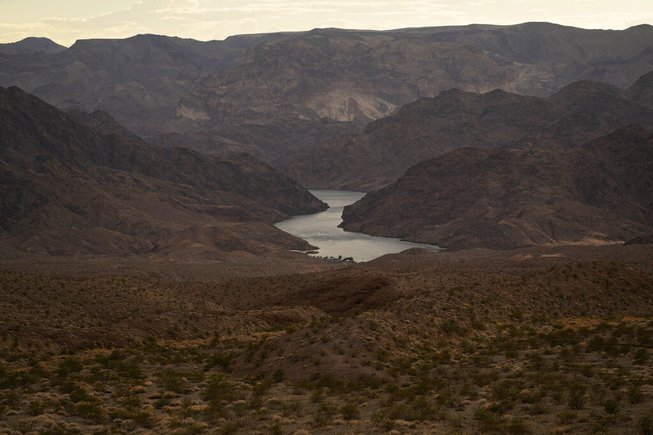
John Locher / AP
Water flows down the Colorado River downriver from Hoover Dam in northwest Arizona, on Aug. 14, 2022, near the Lake Mead National Recreation Area.
Published Wednesday, Dec. 13, 2023 | 1:26 p.m.
Updated Wednesday, Dec. 13, 2023 | 2:34 p.m.
California water districts and Bureau of Reclamation officials today commemorated a series of 21 water conservation agreements that will save 1.6 million acre feet of Colorado River water through 2026.
Officials with the Imperial Irrigation District, San Diego County Water Authority, Coachella Valley Water District, Palo Verde Irrigation District and the Quechan Indian Tribe signed the agreements at the annual Colorado River Water Users Association meeting at Paris Las Vegas.
JB Hamby, Colorado River commissioner for California and chairman of California’s Colorado River Board, said the agreements mean 1.6 million acre feet of water will stay in Lake Mead between now and 2026. An acre-foot of water is about 326,000 gallons and enough to serve two to three households annually.
The water districts will receive millions of dollars in Inflation Reduction Act funding for their conservation efforts.
The Lower Colorado River Basin System Conservation and Efficiency Program will administer the payments.
The West is mired in a two-decade drought that is leaving less water flowing through Colorado and its tributaries. The result is depleted reservoirs that store the water that allows the West to thrive.
Those reservoirs — Lake Powell and Lake Mead — are still only about 39% and 33% full, respectively, according to the U.S. Bureau of Reclamation.
Last summer, Bureau of Reclamation Commissioner Camille Touton asked for 2 million to 4 million acre feet of water reductions “to prevent us from hitting deadpool in Lake Powell and Lake Mead,” Hamby said. Deadpool means the reservoir no longer has enough water.
Touton said the Coachella Valley Water District will conserve 105,000 acre feet of water through 2025, while the Imperial Irrigation District will conserve 100,000 acre feet this year.
The Quechan Indian Tribe will conserve 39,000 acre feet through 2025.
Palo Verde will negotiate its part with the bureau later this week, along with Palo Verde, and the Coachella Water District will approve a second agreement within a few weeks.
“These agreements will commit more than 1.5 million acre feet to system conservation through 2026,” Touton said.
Hamby is also vice president of the Imperial Irrigation District’s board of directors. The irrigation district, which is the largest in the nation, holds a 3.1 million acre-feet annual entitlement and usually gets spared from conservation cuts because of its senior water rights.
Hamby said each water district will use the funding for a different conservation project. For example, Palo Verde is planning a fallowing program, the Quechan tribe is planning an irrigation program, and Imperial is planning an irrigation efficiency program focused on farms.
About 40 million people rely on the river for water. Nevada has rights to 1.8% of the river's water through the Colorado River Compact, which was signed in 1922.
Adel Hagekhalil, general manager for the Metropolitan Water District of Southern California, said the Colorado River has been a lifeline for nearly 100 years and the agreements are a key part of preserving it.
“There’s so much work ahead of us. Time is not on our side. Nature threw us a lifeline this year; let’s take advantage of it," he said of monsoonal storms in early September that helped keep water levels from further decreasing.
States put forward multiple conservation plans this year, including one that would see Arizona, California and Nevada conserve 3 million acre feet through 2026 in exchange for $1.2 billion in federal funding.
If approved by the Interior Department, that plan would have included rare cuts for the usually exempt Imperial Irrigation District.
Officials have been discussing paying water districts to conserve water since early this year.
The Department of Interior announced in May that Inflation Reduction Act funding would compensate water districts for 2.3 million acre feet of cuts across the three Lower Basin states, California, Nevada and Arizona.
